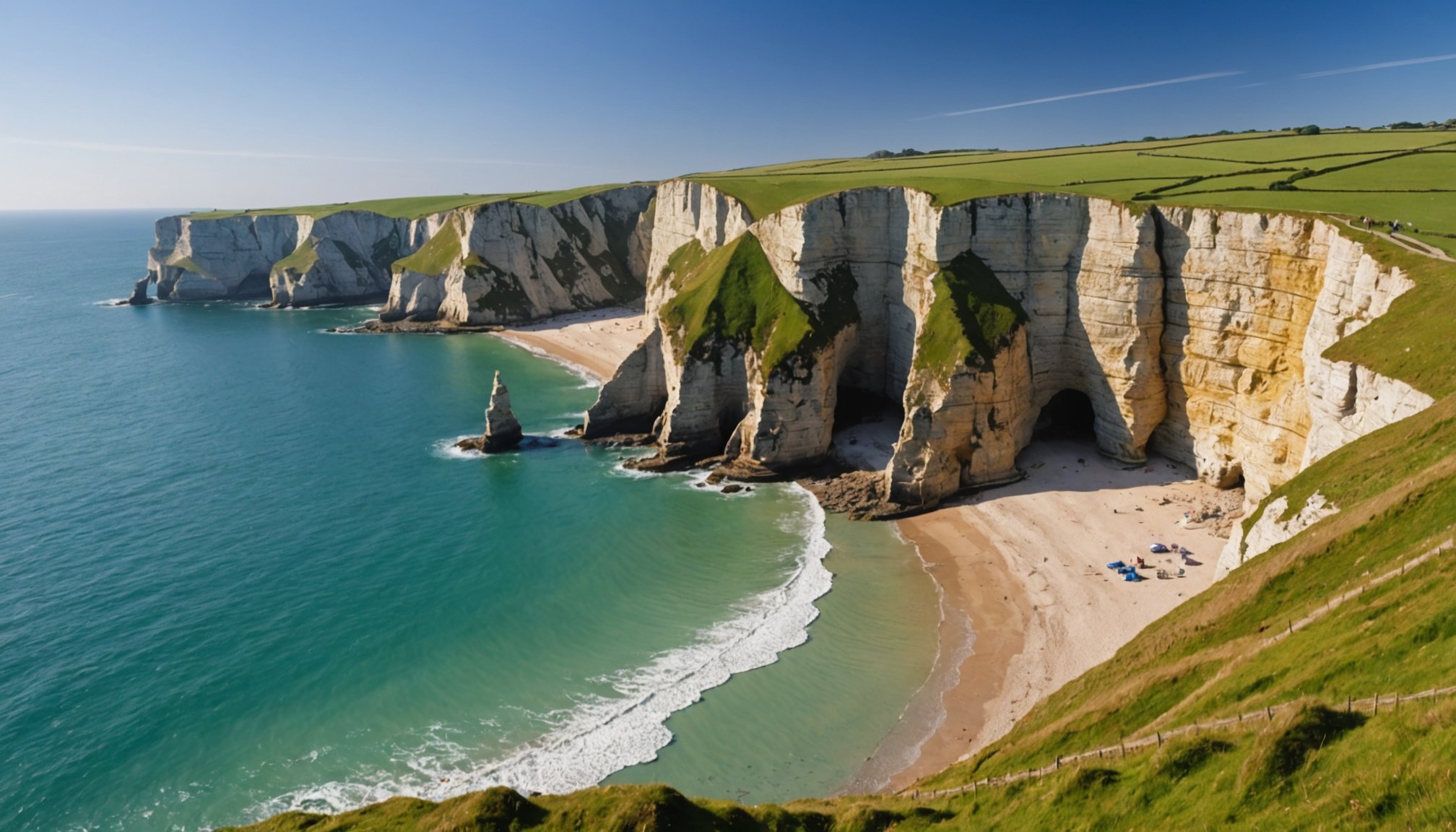Inspiring Locations for Photography in Dorset
Dorset is celebrated for its dramatic coastal cliffs and abundant photography hotspots. Exploring the scenic landscapes of this southwest English region offers numerous opportunities for photographers, from amateurs to professionals.
Renowned Coastal Cliff Locations
Key locations in Dorset include the iconic Durdle Door and Lulworth Cove. Durdle Door, with its majestic limestone arch, is a favourite for capturing sunrise and sunset shots. The natural curves and contrasts of Lulworth Cove are perfect for creating compelling compositions through varying tides and light conditions. Both sites, part of the Jurassic Coast, offer photographers a chance to capture prehistoric beauty.
This might interest you : Uncover the best guided tours of renowned university towns in the uk
Unique Features
Durdle Door and Lulworth Cove each offer unique photographic opportunities. Durdle Door’s sweeping arch frames the sky and sea, providing a natural focal point. Lulworth Cove’s circular bay and chalk cliffs offer striking contrasts and opportunities for creative angles and perspectives.
Access Information and Best Times
These locations are accessible year-round, with parking available nearby. For the best lighting conditions, visiting during the early morning or late afternoon offers optimal natural lighting. During these times, the area is less crowded, enhancing the photography experience and allowing for uninterrupted exploration of Dorset’s stunning coastal cliffs.
Additional reading : Discover 42 must-try experiences in Rome for your visit
Tips for Capturing Stunning Coastal Cliff Photos
Mastering framing techniques and effective composition is crucial for capturing the breathtaking Dorset coastal cliffs. When approaching landscape photography, consider leading lines and the rule of thirds, which can guide the viewer’s eye through the image. Position the main subject, like the arch of Durdle Door, distinctly within the frame to draw focus.
Camera settings also play a pivotal role. For low-light conditions such as the golden hour, use a wide aperture (around f/2.8 to f/4) to allow more light and create a pleasing depth of field. Adjusting the ISO to maintain image quality and reduce noise, especially in dim environments, is essential. A longer exposure can help capture the movement of waves or clouds, adding a dynamic element to static landscapes.
Natural elements, like the play of light and shadow on scenic landscapes, enhance the depth and texture of your photographs. Incorporating elements from the environment, such as coastal flora or the rocky textures of Dorset’s cliffs, can add layers and interest to your composition. Perseverance and practice in these techniques will elevate your shots, transforming a simple scene into stunning visual storytelling. Immerse yourself, and let the natural beauty of Dorset inspire your creativity.
Optimal Times for Photography in Dorset
Understanding the importance of the golden hour is crucial when photographing Dorset’s coastal cliffs. Occurring shortly after sunrise and before sunset, this period offers soft, diffused light. It creates a warm, natural glow, enhancing the scenic landscapes and making them appear more vibrant and dramatic. This lighting is ideal for capturing the rugged textures and natural beauty of the Dorset coast.
Seasonal Photography Variations
Dorset’s photography hotspots showcase different hues as seasons change. In spring, the coastal cliffs are adorned with wildflowers, adding splashes of colour to your compositions. Summer provides longer daylight hours, offering ample time to capture the cliffs in different lights. Autumn, with its golden and red foliage, enhances the scenes with rich, warm tones, while winter presents unique opportunities to capture the area’s stark beauty against dramatic skies, offering an ethereal quality to photographs.
Ideal Weather Conditions
For dramatic visuals, overcast days can accentuate the contrast and depth of your photos, ideal for landscape photography. Clear skies during the golden hour bring out vibrant colours, while light rain can enhance texture and reflections on the sea. Always check local weather forecasts before heading out to ensure you maximise favourable conditions for your photographic pursuits.
Essential Gear and Equipment for Cliff Photography
When capturing the beauty of Dorset’s coastal cliffs, having the right photography equipment is crucial. Selecting the appropriate camera and lenses can enhance your photographic results significantly. A DSLR or mirrorless camera, paired with wide-angle lenses, helps encapsulate the vastness of scenic landscapes and highlights intricate details of your subject.
Filters are indispensable for managing exposure, especially during the dynamic lighting conditions of the golden hour. A neutral density filter can balance bright skies, while a polarising filter deepens contrasts and enriches sky and sea colours. Tripods are equally important, providing stability for long exposures, essential for capturing motion in waves and clouds without blur.
Accessorising your camera gear with lens hoods, for glare reduction, and a sturdy camera bag to protect your equipment against the rugged coastal environment is wise. Consider weatherproof gear to withstand the elements prevalent in photography hotspots.
- DSLR or Mirrorless Cameras: Offer flexibility and control for landscape shots.
- Wide-angle Lenses: Capture expansiveness and detail.
- Filters and Tripods: Essential for exposure management and stability.
- Weatherproof Accessories: Safeguard gear from elements.
These choices ensure that your equipment supports your creative vision, maximising photography potential.
Personal Experiences and Stories from the Cliffs
Embarking on a photographic journey across Dorset’s coastal cliffs can be as rewarding as it is thrilling. Travel stories often highlight awe-inspiring moments, like witnessing dawn break through the Durdle Door arch or capturing the fiery hues of a Lulworth Cove sunset. Each excursion brings its set of challenges, such as navigating rocky trails or battling unpredictable weather, yet these experiences add depth to the personal anecdotes told through images.
Capturing the essence of Dorset’s scenic landscapes involves more than technical skill; it demands a connection to nature. Many photographers recount how the sound of the crashing waves and the feel of the coastal breeze fuel their creativity. It’s in these moments that the cliffs reveal their secrets: the subtle colour shifts in the evening light, or the way morning mist hugs the landscapes.
This journey is also about discovering one’s creative inspiration through the lens, finding angles and perspectives previously unseen. The connection between the photographer and the cliffs is intimate, woven into every image produced. These photography experiences remind us of nature’s enduring beauty and our role in capturing and sharing it with the world.
Travel Logistics for a Photography Trip to Dorset
Planning a photography trip to Dorset’s coastal cliffs involves thoughtful consideration of logistics to enhance your photography experience. Dorset can be accessed via train, with lines running to stations like Weymouth or Wareham. From there, local buses or car rentals offer flexibility to reach iconic spots such as Durdle Door and Lulworth Cove.
Accommodations near these photography hotspots range from charming bed-and-breakfasts to budget-friendly hostels. Opt for locations in West Lulworth or Weymouth for proximity to key sites. Staying nearby allows photographers to take advantage of early morning or late afternoon light, optimizing shooting hours.
To maximise your scenic landscape captures, devise an itinerary that considers both the golden hour and tide schedules. The interplay of light and water at different times, particularly during sunrise or sunset, can transform the same location, presenting varied photographic opportunities.
Ensure to pack weather-appropriate clothing and footwear, as Dorset’s weather can be unpredictable. These practical travel tips enhance comfort and safety, allowing photographers to focus on their creative pursuits. Embrace the logistics of your journey, knowing they lay the foundation for capturing the breathtaking beauty of Dorset’s coastal cliffs.











